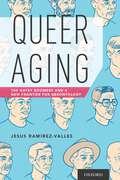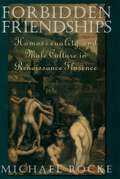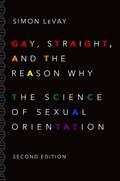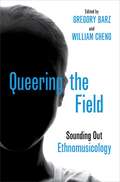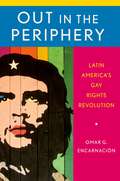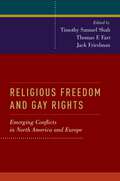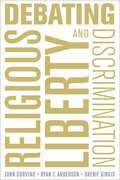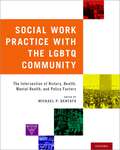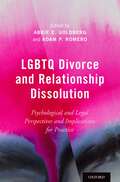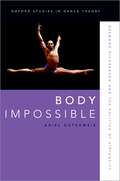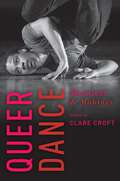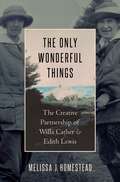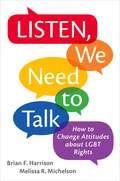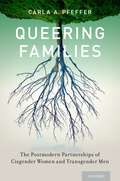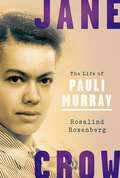- Table View
- List View
Queer Aging: The Gayby Boomers and a New Frontier for Gerontology
by Jesus Ramirez-VallesAs the first generation of gay men enters its autumn years, these men's responses to the physical and emotional tolls of aging promise to be as revolutionary as their advances in AIDS and civil rights activism. Older gay men's approaches to friendship, caregiving, romantic and sexual relationships, illness, and bereavement is upending conventional wisdom regarding the aging process, LGBTQ communities, and the entire field of gerontology. QUEER AGING comprises scholar Jesus Ramirez-Valles's probing conversations with 11 racially and economically diverse representatives of this pioneering generation of gay men-the gayby boomers. Through candid, first-person narratives, Ramirez-Valles's subjects reflect on their varied experiences as late career professionals, retirees, AIDS survivors, caregivers for ailing partners, and witnesses to profound social and cultural change. Framed within a larger introduction to both Queer Theory and its history, these reflections provide context for understanding the aging arc and experience of older gay men. Spanning sociology, history, cultural studies, and social work, QUEER AGING will be a vital resource for students as well as health professionals who serve the gay community and communities of color.
Forbidden Friendships: Homosexuality and Male Culture in Renaissance Florence (Studies in the History of Sexuality)
by Michael Rocke"This is a superb work of scholarship, impossible to overpraise.... It marks a milestone in the 20-year rise of gay and lesbian studies."--Martin Duberman, The Advocate The men of Renaissance Florence were so renowned for sodomy that "Florenzer" in German meant "sodomite." In the late fifteenth century, as many as one in two Florentine men had come to the attention of the authorities for sodomy by the time they were thirty. In 1432 The Office of the Night was created specifically to police sodomy in Florence. Indeed, nearly all Florentine males probably had some kind of same-sex experience as a part of their "normal" sexual life. Seventy years of denunciations, interrogations, and sentencings left an extraordinarily detailed record, which author Michael Rocke has used in his vivid depiction of this vibrant sexual culture in a world where these same-sex acts were not the deviant transgressions of a small minority, but an integral part of a normal masculine identity. Rocke roots this sexual activity in the broader context of Renaissance Florence, with its social networks of families, juvenile gangs, neighbors, patronage, workshops, and confraternities, and its busy political life from the early years of the Republic through the period of Lorenzo de' Medici, Savonarola, and the beginning of Medici princely rule. His richly detailed book paints a fascinating picture of Renaissance Florence and calls into question our modern conceptions of gender and sexual identity.
Gay, Straight, and the Reason Why: The Science of Sexual Orientation
by Simon LeVayWhat causes a child to grow up gay or straight? Neuroscientist Simon LeVay summarizes a wealth of scientific evidence that points to one inescapable conclusion: Sexual orientation results primarily from an interaction between genes, sex hormones, and the cells of the developing body and brain. LeVay takes the reader on a whirlwind tour of laboratories that specialize in genetics, endocrinology, neuroscience, cognitive psychology, evolutionary psychology, and family demographics. He describes, for instance, how researchers have manipulated the sex hormone levels of animals during development, causing them to mate preferentially with animals of their own gender. In this second edition, LeVay adds a chapter on bisexuality, reviews some uncommon forms of sexuality, and considers whether there could be a biological basis for subtypes of gay people such as "butch" and "femme" lesbians.
Gay, Straight, and the Reason Why: The Science of Sexual Orientation
by Simon LeVayWhat causes a child to grow up gay or straight? Neuroscientist Simon LeVay summarizes a wealth of scientific evidence that points to one inescapable conclusion: Sexual orientation results primarily from an interaction between genes, sex hormones, and the cells of the developing body and brain. LeVay takes the reader on a whirlwind tour of laboratories that specialize in genetics, endocrinology, neuroscience, cognitive psychology, evolutionary psychology, and family demographics. He describes, for instance, how researchers have manipulated the sex hormone levels of animals during development, causing them to mate preferentially with animals of their own gender. In this second edition, LeVay adds a chapter on bisexuality, reviews some uncommon forms of sexuality, and considers whether there could be a biological basis for subtypes of gay people such as "butch" and "femme" lesbians.
Queering the Field: Sounding Out Ethnomusicology
Drawing on ethnographic research and often deeply personal experiences with musical cultures, Queering the Field: Sounding out Ethnomusicology unpacks a history of sentiment that veils the treatment of queer music and identity within the field of ethnomusicology. The thematic structure of the volume reflects a deliberate cartography of queer spaces in the discipline-spaces that are strongly present due to their absence, are marked by direct sonic parameters, or are called into question by virtue of their otherness. As the first large-scale study of ethnomusicology's queer silences and queer identity politics, Queering the Field directly addresses the normativities currently at play in musical ethnography (fieldwork, analysis, performance, transcription) as well as in the practice of musical ethnographers (identification, participation, disclosure, observation, authority). While rooted in strong narrative convictions, the authors frequently adopt radicalized voices with the goal of queering a hierarchical sexual binary. The essays in the volume present rhetorical and syntactical scenarios that challenge us to read in prescient singular ways for future queer writing and queer thought in ethnomusicology.
QUEERING THE FIELD C: Sounding Out Ethnomusicology
by Gregory Barz and William ChengDrawing on ethnographic research and often deeply personal experiences with musical cultures, Queering the Field: Sounding out Ethnomusicology unpacks a history of sentiment that veils the treatment of queer music and identity within the field of ethnomusicology. The thematic structure of the volume reflects a deliberate cartography of queer spaces in the discipline-spaces that are strongly present due to their absence, are marked by direct sonic parameters, or are called into question by virtue of their otherness. As the first large-scale study of ethnomusicology's queer silences and queer identity politics, Queering the Field directly addresses the normativities currently at play in musical ethnography (fieldwork, analysis, performance, transcription) as well as in the practice of musical ethnographers (identification, participation, disclosure, observation, authority). While rooted in strong narrative convictions, the authors frequently adopt radicalized voices with the goal of queering a hierarchical sexual binary. The essays in the volume present rhetorical and syntactical scenarios that challenge us to read in prescient singular ways for future queer writing and queer thought in ethnomusicology.
OUT IN THE PERIPHERY C: Latin America's Gay Rights Revolution
by Omar G. EncarnaciónKnown around the world as a bastion of Catholicism and machismo, Latin America has emerged in recent years as the undisputed gay rights leader of the Global South. Even more surprising is that several Latin American nations have surpassed many developed nations, including the United States, in legislating equality for the LGBT community. So how did this dramatic and unexpected expansion of gay rights come about? And why are Latin American nations diverging in their embrace of gay rights, a point highlighted by the paradoxical experiences of Argentina and Brazil? Argentina, a country with a dark history of repression of homosexuality, legalized same-sex marriage in 2010, a first for a Latin American nation; and since then it has enacted laws to ensure transgender equality, to abolish "ex-gay reparative therapy," and to provide reproductive assistance to same-sex couples. By contrast, Brazil, a country famous for celebrating sexual diversity, proved incapable of legalizing same-sex marriage via the legislature, leaving the job to the courts; and Brazilian anti-gay discrimination laws are among the weakest in Latin America. In Out in the Periphery, Omar G. Encarnación breaks away from the conventional narrative of Latin America's embrace of gay rights as a by-product of the global spread of gay rights from the developed West. Instead, Encarnación aims to "decenter" gay rights politics. His intention is not to demonstrate how the "local" has trumped the "global" in Latin America but rather to suggest how domestic and international politics interacted to make Latin America one of the world's most receptive environments for gay rights. Economic and political modernization, constitutional and judicial reforms, and the rise of socially liberal governments have all contributed to this receptivity. But the most decisive factor was the skill of local activists in crafting highly effective gay rights campaigns. Inspired by external events and trends, but firmly grounded in local politics and realities, these campaigns succeeded in bringing radical change to the law with respect to homosexuality and, in some cases, as in Argentina, in transforming society and the culture at large.
The Wallflower Avant-Garde: Modernism, Sexuality, and Queer Ekphrasis
by Brian GlaveyThe Wallflower Avant-Garde highlights a strain of formalism visible in both modernist literature and contemporary queer studies, drawing attention to an aesthetic that is as quiet and quirky as it is queer. In studies of Gertrude Stein, Djuna Barnes, Richard Bruce Nugent, Frank O'Hara, and John Ashbery, Brian Glavey argues for a recalibrated understanding of the relation between sexuality and the aesthetic, revealing a non-oppositional avant-gardism that opts out of some of the binaristic imperatives that have structured recent debates in queer theory. Refusing to decide between positive and negative affects or to side with either utopian or antisocial ambitions, The Wallflower Avant-Garde explores models of reading and writing about art that remain flexible enough to dig deep even as they gloss the surface. At the heart of this argument is a revaluation of modernist ekphrasis, a mode understood as literature's imitation or description of the visual arts. From the well-wrought urns of the New Critics onward, ekphrasis has figured prominently in the legacy of modernist literary criticism, but a tendency to read its complicated modes of relationality in terms of either autonomy or antagonism has obscured the forms of creative failure and imitation embodied in the desire to confuse poetry for pottery. Attending to mimetic and descriptive strategies without dismissing the aspirations for wholeness and closure that often animate them allows for the recognition that queerness and modernism are intertwined in unexpected and unpredictable ways, revealing new insights into the varieties of abstraction, preterition, and spatial form that stand behind modernism's investment in the aesthetic.
Religious Freedom and Gay Rights: Emerging Conflicts in the United States and Europe
by Jack FriedmanIn the United States and Europe, an increasing emphasis on equality has pitted rights claims against each other, raising profound philosophical, moral, legal, and political questions about the meaning and reach of religious liberty. Nowhere has this conflict been more salient than in the debate between claims of religious freedom, on one hand, and equal rights claims made on the behalf of members of the lesbian, gay, bisexual, and transgender (LGBT) community, on the other. As new rights for LGBT individuals have expanded in liberal democracies across the West, longstanding rights of religious freedom -- such as the rights of religious communities to adhere to their fundamental teachings, including protecting the rights of conscience; the rights of parents to impart their religious beliefs to their children; and the liberty to advance religiously-based moral arguments as a rationale for laws -- have suffered a corresponding decline. Timothy Samuel Shah, Thomas F. Farr, and Jack Friedman's volume, Religious Freedom and Gay Rights brings together some of the world's leading thinkers on religion, morality, politics, and law to analyze the emerging tensions between religious freedom and gay rights in three key geographic regions: the United States, the United Kingdom, and continental Europe. What implications will expanding regimes of equality rights for LGBT individuals have on religious freedom in these regions? What are the legal and moral frameworks that govern tensions between gay rights and religious freedom? How are these tensions illustrated in particular legal, political, and policy controversies? And what is the proper way to balance new claims of equality against existing claims for freedom of religious groups and individuals? Religious Freedom and Gay Rights offers several explorations of these questions.
Debating Religious Liberty and Discrimination
by John Corvino Ryan T. Anderson Sherif GirgisVirtually everyone supports religious liberty, and virtually everyone opposes discrimination. But how do we handle the hard questions that arise when exercises of religious liberty seem to discriminate unjustly? How do we promote the common good while respecting conscience in a diverse society? This point-counterpoint book brings together leading voices in the culture wars to debate such questions: John Corvino, a longtime LGBT-rights advocate, opposite Ryan T. Anderson and Sherif Girgis, prominent young social conservatives. Many such questions have arisen in response to same-sex marriage: How should we treat county clerks who do not wish to authorize such marriages, for example; or bakers, florists, and photographers who do not wish to provide same-sex wedding services? But the conflicts extend well beyond the LGBT rights arena. How should we treat hospitals, schools, and adoption agencies that can't in conscience follow antidiscrimination laws, healthcare mandates, and other regulations? Should corporations ever get exemptions? Should public officials? Should we keep controversial laws like the Religious Freedom Restoration Act, or pass new ones like the First Amendment Defense Act? Should the law give religion and conscience special protection at all, and if so, why? What counts as discrimination, and when is it unjust? What kinds of material and dignitary harms should the law try to fight-and what is dignitary harm, anyway? Beyond the law, how should we treat religious beliefs and practices we find mistaken or even oppressive? Should we tolerate them or actively discourage them? In point-counterpoint format, Corvino, Anderson and Girgis explore these questions and more. Although their differences run deep, they tackle them with civility, clarity, and flair. Their debate is an essential contribution to contemporary discussions about why religious liberty matters and what respecting it requires.
DEBATING RELIGIOUS LIBERTY & DISCRIMIN C
by Sherif Girgis Ryan T. Anderson John CorvinoVirtually everyone supports religious liberty, and virtually everyone opposes discrimination. But how do we handle the hard questions that arise when exercises of religious liberty seem to discriminate unjustly? How do we promote the common good while respecting conscience in a diverse society? This point-counterpoint book brings together leading voices in the culture wars to debate such questions: John Corvino, a longtime LGBT-rights advocate, opposite Ryan T. Anderson and Sherif Girgis, prominent young social conservatives. Many such questions have arisen in response to same-sex marriage: How should we treat county clerks who do not wish to authorize such marriages, for example; or bakers, florists, and photographers who do not wish to provide same-sex wedding services? But the conflicts extend well beyond the LGBT rights arena. How should we treat hospitals, schools, and adoption agencies that can't in conscience follow antidiscrimination laws, healthcare mandates, and other regulations? Should corporations ever get exemptions? Should public officials? Should we keep controversial laws like the Religious Freedom Restoration Act, or pass new ones like the First Amendment Defense Act? Should the law give religion and conscience special protection at all, and if so, why? What counts as discrimination, and when is it unjust? What kinds of material and dignitary harms should the law try to fight-and what is dignitary harm, anyway? Beyond the law, how should we treat religious beliefs and practices we find mistaken or even oppressive? Should we tolerate them or actively discourage them? In point-counterpoint format, Corvino, Anderson and Girgis explore these questions and more. Although their differences run deep, they tackle them with civility, clarity, and flair. Their debate is an essential contribution to contemporary discussions about why religious liberty matters and what respecting it requires.
RELIGIOUS FREEDOM & GAY RIGHTS C: Emerging Conflicts in the United States and Europe
by Jack FriedmanIn the United States and Europe, an increasing emphasis on equality has pitted rights claims against each other, raising profound philosophical, moral, legal, and political questions about the meaning and reach of religious liberty. Nowhere has this conflict been more salient than in the debate between claims of religious freedom, on one hand, and equal rights claims made on the behalf of members of the lesbian, gay, bisexual, and transgender (LGBT) community, on the other. As new rights for LGBT individuals have expanded in liberal democracies across the West, longstanding rights of religious freedom -- such as the rights of religious communities to adhere to their fundamental teachings, including protecting the rights of conscience; the rights of parents to impart their religious beliefs to their children; and the liberty to advance religiously-based moral arguments as a rationale for laws -- have suffered a corresponding decline. Timothy Samuel Shah, Thomas F. Farr, and Jack Friedman's volume, Religious Freedom and Gay Rights brings together some of the world's leading thinkers on religion, morality, politics, and law to analyze the emerging tensions between religious freedom and gay rights in three key geographic regions: the United States, the United Kingdom, and continental Europe. What implications will expanding regimes of equality rights for LGBT individuals have on religious freedom in these regions? What are the legal and moral frameworks that govern tensions between gay rights and religious freedom? How are these tensions illustrated in particular legal, political, and policy controversies? And what is the proper way to balance new claims of equality against existing claims for freedom of religious groups and individuals? Religious Freedom and Gay Rights offers several explorations of these questions.
Social Work Practice with the LGBTQ Community: The Intersection of History, Health, Mental Health, and Policy Factors
Social Work Practice with the LGBTQ Community aims to weave together the realms of sociopolitical, historical, and policy contexts in order to assist readers with understanding the base for effective and affirming health and mental health practice with diverse members of the LGBTQ community. Comprised of chapters written by social work academics and their allies -- whose combined knowledge in the field spans decades of direct experience in human behavior, practice, policy, and research -- this book features applicable and useful content for social work students and practitioners across the allied health and mental health professions, as well as across disciplines. The expansive practice text examines international concerns and content associated with the LGBTQ movement and ongoing needs related to health, mental health, policy and advocacy, among other areas of concern. Specific highlights of the chapters include narrative that blends conceptual, theoretical, and empirical content; examination of current trends in the field related to practice considerations and intersectionality; and snapshots of concerns related to international progress and ongoing challenges related to equality and policy. Additionally, as a classroom support for instructors, each chapter has a corresponding power point presentation which includes a resource list pertaining to that chapter's focus with websites, film, and video links as well as national and international organizations associated with the LGBTQ community. Overall, Social Work Practice with the LGBTQ Community is an invaluable resource for graduate students within social work programs and related disciplines, academics, and health/mental health practitioners currently in the field.
Social Work Practice with the LGBTQ Community: The Intersection of History, Health, Mental Health, and Policy Factors
by Michael P. DentatoSocial Work Practice with the LGBTQ Community aims to weave together the realms of sociopolitical, historical, and policy contexts in order to assist readers with understanding the base for effective and affirming health and mental health practice with diverse members of the LGBTQ community. Comprised of chapters written by social work academics and their allies -- whose combined knowledge in the field spans decades of direct experience in human behavior, practice, policy, and research -- this book features applicable and useful content for social work students and practitioners across the allied health and mental health professions, as well as across disciplines. The expansive practice text examines international concerns and content associated with the LGBTQ movement and ongoing needs related to health, mental health, policy and advocacy, among other areas of concern. Specific highlights of the chapters include narrative that blends conceptual, theoretical, and empirical content; examination of current trends in the field related to practice considerations and intersectionality; and snapshots of concerns related to international progress and ongoing challenges related to equality and policy. Additionally, as a classroom support for instructors, each chapter has a corresponding power point presentation which includes a resource list pertaining to that chapter's focus with websites, film, and video links as well as national and international organizations associated with the LGBTQ community. Overall, Social Work Practice with the LGBTQ Community is an invaluable resource for graduate students within social work programs and related disciplines, academics, and health/mental health practitioners currently in the field.
LGBTQ Divorce and Relationship Dissolution: Psychological and Legal Perspectives and Implications for Practice
What unique challenges face LGBTQ individuals in relationships or who are separating or divorcing, especially now that same-sex couples may marry? What issues might complicate the ending of relationships when children, multiple partners, or multiple parents are present? How do gender, gender transition, ethnicity, immigration status, economic status, geography, and other characteristics shape the experiences of divorcing or separating LGBTQ people? Finally, how can therapists and lawyers most effectively assist LGBTQ people whose relationships and families are dissolving? LGBTQ Divorce and Relationship Dissolution: Psychological and Legal Perspectives and Implications for Practice brings together social science and legal perspectives to examine the timely topic of relationship dissolution and divorce among sexual and gender minorities. The first edited book to tackle this topic in an informed, comprehensive, and interdisciplinary matter, this volume gathers and expands current knowledge on topics such as LGBTQ people's relationship and dissolution patterns; the divorce and child custody rules and processes that now apply to many LGBTQ families; and the surrounding political and cultural environment in the United States. It will also address practical issues such as mediation with same-sex couples who are separating or divorcing, financial planning, and family therapy for sexual minority parents and their children in the context of divorce/dissolution. With chapters contributed by leading scholars and practitioners from law, political science, psychology, sociology, and other disciplines, LGBTQ Divorce and Relationship Dissolution will be an invaluable resource for academics, practitioners, policymakers, and LGBTQ people. It will also be of interest to students in psychology, counseling, law, and LGBTQ and gender studies.
Body Impossible: Desmond Richardson and the Politics of Virtuosity (Oxford Studies in Dance Theory)
by Ariel OsterweisBody Impossible theorizes the concept of virtuosity in contemporary dance and performance through a study of the career of dancer Desmond Richardson. A virtuoso for the ages, Richardson is renowned for delivering commanding performances over decades in contexts ranging from the stages of the Alvin Ailey American Dance Theater and Ballett Frankfurt to featured appearances with Michael Jackson and Prince, along with his work as co-founder of Complexions Contemporary Ballet, inaugurating a virtuosic queer black aesthetic with choreographer Dwight Rhoden. Focusing on Richardson's creative insistence on improvisatory fun and excellence throughout the decades approaching the millennium (shaped by Reaganism, the Culture Wars, the AIDS epidemic, the New Jim Crow, and MTV), this book brings dance into conversation with paradigms of blackness, queerness, masculinity, and class in order to generate a socioculturally attentive understanding of virtuosity. Virtuosity obscures the border between popular and concert performance, and Richardson's versatility epitomizes the demands on the contemporary virtuosic dance artist. Author Ariel Osterweis suggests that discourses of virtuosity are linked to connotations of excess, and that an examination of the formal and socio-cultural aspects of virtuosic performance reveals under-recognized heterogeneity in which we detect ?vernacular? influences on ?high art.? In doing so, Body Impossible accounts for the constitutive relationship between disciplined perceptions of virtuosity's excess and the disciplining of the racialized body in national and transnational contexts.
Body Impossible: Desmond Richardson and the Politics of Virtuosity (Oxford Studies in Dance Theory)
by Ariel OsterweisBody Impossible theorizes the concept of virtuosity in contemporary dance and performance through a study of the career of dancer Desmond Richardson. A virtuoso for the ages, Richardson is renowned for delivering commanding performances over decades in contexts ranging from the stages of the Alvin Ailey American Dance Theater and Ballett Frankfurt to featured appearances with Michael Jackson and Prince, along with his work as co-founder of Complexions Contemporary Ballet, inaugurating a virtuosic queer black aesthetic with choreographer Dwight Rhoden. Focusing on Richardson's creative insistence on improvisatory fun and excellence throughout the decades approaching the millennium (shaped by Reaganism, the Culture Wars, the AIDS epidemic, the New Jim Crow, and MTV), this book brings dance into conversation with paradigms of blackness, queerness, masculinity, and class in order to generate a socioculturally attentive understanding of virtuosity. Virtuosity obscures the border between popular and concert performance, and Richardson's versatility epitomizes the demands on the contemporary virtuosic dance artist. Author Ariel Osterweis suggests that discourses of virtuosity are linked to connotations of excess, and that an examination of the formal and socio-cultural aspects of virtuosic performance reveals under-recognized heterogeneity in which we detect ?vernacular? influences on ?high art.? In doing so, Body Impossible accounts for the constitutive relationship between disciplined perceptions of virtuosity's excess and the disciplining of the racialized body in national and transnational contexts.
QUEER DANCE C
by Clare CroftIf we imagine multiple ways of being together, how might that shift choreographic practices and help us imagine ways groups assemble in more varied ways than just pairing another man with another woman? How might dancing queerly ask us to imagine futures through something other than heterosexuality and reproduction? How does challenging gender binaries always mean thinking about race, thinking about the postcolonial, about ableism? What are the arbitrary rules structuring dance in all its arenas, whether concert and social or commercial and competition, and how do we see those invisible structures and work to disrupt them? Queer Dance brings together artists and scholars in a multi-platformed project-book, accompanying website, and live performance series to ask, "How does dancing queerly progressively challenge us?" The artists and scholars whose writing appears in the book and whose performances and filmed interviews appear online stage a range of genders and sexualities that challenge and destabilize social norms. Engaging with dance making, dance scholarship, queer studies, and other fields, Queer Dance asks how identities, communities, and artmaking and scholarly practices might consider what queer work the body does and can do. There is great power in claiming queerness in the press of bodies touching or in the exceeding of the body best measured in sweat and exhaustion. How does queerness exist in the realm of affect and touch, and what then might we explore about queerness through these pleasurable and complex bodily ways of knowing?
The Only Wonderful Things: The Creative Partnership of Willa Cather & Edith Lewis
by Melissa J. HomesteadA groundbreaking new look at American novelist Willa Cather's creative process What would Willa Cather's widely read and cherished novels have looked like if she had never met magazine editor and copywriter Edith Lewis? In this groundbreaking book on Cather's relationship with her life partner, author Melissa J. Homestead counters the established portrayal of Cather as a solitary genius and reassesses the role that Lewis, who has so far been rendered largely invisible by scholars, played in shaping Cather's work. Inviting Lewis to share the spotlight alongside this pivotal American writer, Homestead argues that Lewis was not just Cather's companion but also her close literary collaborator and editor. Drawing on an array of previously unpublished sources, Homestead skillfully reconstructs Cather and Lewis's life together, from their time in New York City to their travels in the American Southwest that formed the basis of the novels The Professor's House and Death Comes for the Archbishop. After Cather's death and in the midst of the Cold War panic over homosexuality, the story of her life with Edith Lewis could not be told, but by telling it now, Homestead offers a refreshing take on lesbian life in early twentieth-century America.
The Only Wonderful Things: The Creative Partnership of Willa Cather & Edith Lewis
by Melissa J. HomesteadA groundbreaking new look at American novelist Willa Cather's creative process What would Willa Cather's widely read and cherished novels have looked like if she had never met magazine editor and copywriter Edith Lewis? In this groundbreaking book on Cather's relationship with her life partner, author Melissa J. Homestead counters the established portrayal of Cather as a solitary genius and reassesses the role that Lewis, who has so far been rendered largely invisible by scholars, played in shaping Cather's work. Inviting Lewis to share the spotlight alongside this pivotal American writer, Homestead argues that Lewis was not just Cather's companion but also her close literary collaborator and editor. Drawing on an array of previously unpublished sources, Homestead skillfully reconstructs Cather and Lewis's life together, from their time in New York City to their travels in the American Southwest that formed the basis of the novels The Professor's House and Death Comes for the Archbishop. After Cather's death and in the midst of the Cold War panic over homosexuality, the story of her life with Edith Lewis could not be told, but by telling it now, Homestead offers a refreshing take on lesbian life in early twentieth-century America.
Listen, We Need to Talk: How to Change Attitudes about LGBT Rights
by Brian F. Harrison Melissa R. MichelsonAmerican public opinion tends to be sticky. Although the news cycle might temporarily affect the public's mood on contentious issues like abortion, the death penalty, or gun control, public opinion toward these issues has remained remarkably constant over decades. There are notable exceptions, however, particularly with regard to divisive issues that highlight identity politics. For example, over the past three decades, public support for same-sex marriage has risen from scarcely more than a tenth to a majority of the population. Why have people's minds changed so dramatically on this issue, and why so quickly? It wasn't just that older, more conservative people were dying and being replaced in the population by younger, more progressive people; people were changing their minds. Was this due to the influence of elite leaders like President Obama? Or advocacy campaigns by organizations pushing for greater recognition of the equal rights of Lesbian, Gay, Bisexual, and Transgender (LGBT) people? Listen, We Need to Talk tests a new theory, what Brian Harrison and Melissa Michelson call The Theory of Dissonant Identity Priming, about how to change people's attitudes on controversial topics. Harrison and Michelson conducted randomized experiments all over the United States, many in partnership with equality organizations, including Equality Illinois, Georgia Equality, Lambda Legal, Equality Maryland, and Louisiana's Capital City Alliance. They found that people are often willing to change their attitudes about LGBT rights when they find out that others with whom they share an identity (for example, as sports fans or members of a religious group) are also supporters of those rights-particularly when told about support from a leader of the group, and particularly if they find the information somewhat surprising. Fans of the Green Bay Packers football team were influenced by hearing that a Packers Hall-of-Famer is a supporter of LGBT rights. African Americans were influenced by hearing that the Black president of the United States is a supporter. Religious individuals were influenced by hearing that a religious leader is a supporter. And strong partisans were influenced by hearing that a leader of their party is a supporter. Through a series of engaging experiments and compelling evidence, Listen, We Need to Talk provides a blueprint for thinking about how to bring disparate groups together over contentious political issues.
LISTEN, WE NEED TO TALK C: How to Change Attitudes about LGBT Rights
by Melissa R. Michelson Brian F. HarrisonAmerican public opinion tends to be sticky. Although the news cycle might temporarily affect the public's mood on contentious issues like abortion, the death penalty, or gun control, public opinion toward these issues has remained remarkably constant over decades. There are notable exceptions, however, particularly with regard to divisive issues that highlight identity politics. For example, over the past three decades, public support for same-sex marriage has risen from scarcely more than a tenth to a majority of the population. Why have people's minds changed so dramatically on this issue, and why so quickly? It wasn't just that older, more conservative people were dying and being replaced in the population by younger, more progressive people; people were changing their minds. Was this due to the influence of elite leaders like President Obama? Or advocacy campaigns by organizations pushing for greater recognition of the equal rights of Lesbian, Gay, Bisexual, and Transgender (LGBT) people? Listen, We Need to Talk tests a new theory, what Brian Harrison and Melissa Michelson call The Theory of Dissonant Identity Priming, about how to change people's attitudes on controversial topics. Harrison and Michelson conducted randomized experiments all over the United States, many in partnership with equality organizations, including Equality Illinois, Georgia Equality, Lambda Legal, Equality Maryland, and Louisiana's Capital City Alliance. They found that people are often willing to change their attitudes about LGBT rights when they find out that others with whom they share an identity (for example, as sports fans or members of a religious group) are also supporters of those rights-particularly when told about support from a leader of the group, and particularly if they find the information somewhat surprising. Fans of the Green Bay Packers football team were influenced by hearing that a Packers Hall-of-Famer is a supporter of LGBT rights. African Americans were influenced by hearing that the Black president of the United States is a supporter. Religious individuals were influenced by hearing that a religious leader is a supporter. And strong partisans were influenced by hearing that a leader of their party is a supporter. Through a series of engaging experiments and compelling evidence, Listen, We Need to Talk provides a blueprint for thinking about how to bring disparate groups together over contentious political issues.
Queering Families: The Postmodern Partnerships of Cisgender Women and Transgender Men (Sexuality, Identity, and Society)
by Carla A. PfefferOzzie and Harriet, move over. A new couple is moving into the neighborhood. In the postmodern era, advances in medical technologies allow some individuals categorized female at birth to live in accordance with their gender identities, as men. While a growing body of literature on transgender men's experiences has come to the forefront, relatively little exists to document the experiences of their partners. In Queering Families: The Postmodern Partnerships of Cisgender Women and Transgender Men, Carla A. Pfeffer brings these experiences to light through interviews with the group most likely to partner and form families with transgender men: non-transgender (cisgender) women. Drawing upon in-depth interviews with fifty cisgender women partners of transgender men from across the United States and Canada, Pfeffer details the experiences of a community that often seems unremarkable and ordinary on its surface. Cisgender women who partner with transgender men who are socially "read" as male are often (mis)perceived as part of a heterosexual couple or family. Yet not all cisgender women who partner with transgender men are comfortable with this invisible existence and comfortable normativity. Instead, many of the cisgender women Pfeffer interviews hold deeply-valued queer identities that may be erased in their partnerships with transgender men. Queering Families details the struggles and strengths of these postmodern "Harriets" as they work to build identities, partnerships, families, and communities. Pfeffer's interviewees discuss the implications of visibility and invisibilty in their everyday lives as they face barriers or pathways to legal and social inclusion. They carve out new lexicons for partners' bodies and their own sexualities, transformed through gender-affirming hormones and surgeries. They plan and construct families with and without children, some drawing upon alternative reproductive technologies to bear the biological offspring of their transgender partners. With remarkable depth and insight, Queering Families explores a shifting social landscape that challenges the very notion of what constitutes a "same-sex" or an "opposite-sex" relationship, marriage, or family.
Queering Families: The Postmodern Partnerships of Cisgender Women and Transgender Men (Sexuality, Identity, and Society)
by Carla A. PfefferOzzie and Harriet, move over. A new couple is moving into the neighborhood. In the postmodern era, advances in medical technologies allow some individuals categorized female at birth to live in accordance with their gender identities, as men. While a growing body of literature on transgender men's experiences has come to the forefront, relatively little exists to document the experiences of their partners. In Queering Families: The Postmodern Partnerships of Cisgender Women and Transgender Men, Carla A. Pfeffer brings these experiences to light through interviews with the group most likely to partner and form families with transgender men: non-transgender (cisgender) women. Drawing upon in-depth interviews with fifty cisgender women partners of transgender men from across the United States and Canada, Pfeffer details the experiences of a community that often seems unremarkable and ordinary on its surface. Cisgender women who partner with transgender men who are socially "read" as male are often (mis)perceived as part of a heterosexual couple or family. Yet not all cisgender women who partner with transgender men are comfortable with this invisible existence and comfortable normativity. Instead, many of the cisgender women Pfeffer interviews hold deeply-valued queer identities that may be erased in their partnerships with transgender men. Queering Families details the struggles and strengths of these postmodern "Harriets" as they work to build identities, partnerships, families, and communities. Pfeffer's interviewees discuss the implications of visibility and invisibilty in their everyday lives as they face barriers or pathways to legal and social inclusion. They carve out new lexicons for partners' bodies and their own sexualities, transformed through gender-affirming hormones and surgeries. They plan and construct families with and without children, some drawing upon alternative reproductive technologies to bear the biological offspring of their transgender partners. With remarkable depth and insight, Queering Families explores a shifting social landscape that challenges the very notion of what constitutes a "same-sex" or an "opposite-sex" relationship, marriage, or family.
Jane Crow: The Life of Pauli Murray
by Rosalind RosenbergThroughout her prodigious life, activist and lawyer Pauli Murray systematically fought against all arbitrary distinctions in society, channeling her outrage at the discrimination she faced to make America a more democratic country. In this definitive biography, Rosalind Rosenberg offers a poignant portrait of a figure who played pivotal roles in both the modern civil rights and women's movements. A mixed-race orphan, Murray grew up in segregated North Carolina before escaping to New York, where she attended Hunter College and became a labor activist in the 1930s. When she applied to graduate school at the University of North Carolina, where her white great-great-grandfather had been a trustee, she was rejected because of her race. She went on to graduate first in her class at Howard Law School, only to be rejected for graduate study again at Harvard University this time on account of her sex. Undaunted, Murray forged a singular career in the law. In the 1950s, her legal scholarship helped Thurgood Marshall challenge segregation head-on in the landmark Brown v. Board of Education case. When appointed by Eleanor Roosevelt to the President's Commission on the Status of Women in 1962, she advanced the idea of Jane Crow, arguing that the same reasons used to condemn race discrimination could be used to battle gender discrimination. In 1965, she became the first African American to earn a JSD from Yale Law School and the following year persuaded Betty Friedan to found an NAACP for women, which became NOW. In the early 1970s, Murray provided Ruth Bader Ginsburg with the argument Ginsburg used to persuade the Supreme Court that the Fourteenth Amendment to the Constitution protects not only blacks but also women - and potentially other minority groups - from discrimination. By that time, Murray was a tenured history professor at Brandeis, a position she left to become the first black woman ordained a priest by the Episcopal Church in 1976. Murray accomplished all this while struggling with issues of identity. She believed from childhood she was male and tried unsuccessfully to persuade doctors to give her testosterone. While she would today be identified as transgender, during her lifetime no social movement existed to support this identity. She ultimately used her private feelings of being "in-between" to publicly contend that identities are not fixed, an idea that has powered campaigns for equal rights in the United States for the past half-century.
